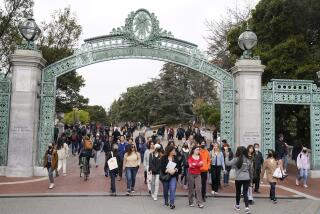Day-Care Web Cameras Help Ease Parents’ Worries
- Share via
COSTA MESA — For Judi McDill, the video window in the corner of her computer screen is the only connection with her son during the day. On the Web, she watches him eat lunch, stand on chairs with that coltish wiggle in his knees, fuss with his shirt buttons. Sometimes, when 5-year-old Chase notices the camera in his day-care center, he waves.
All day, she watches.
Chase was attending Southcoast Early Childhood Learning Center when a man crashed his Cadillac into the playground last year, killing two children.
So when McDill looked for a new school, she was sold on the Newport Harbor Montessori school because of its Webcam service. The Webcam offers “some peace to [my] soul” about her son’s well-being.
“I know it couldn’t prevent something bad happening again, but it gives me reassurance about his safety,” said McDill, 35, of Orange. “The teachers know they are being watched at any time. The biggest thing for me is that I can just see him. I can see him. And I can touch him in some way.”
A year-old Newport Beach company offers the Webcam service, which has been picked up by five Orange County child-care centers and is being considered by five others.
The company provides the schools with $800 computers, the cameras and high-speed Internet connections for free, in exchange for full participation from parents in the Webcam program, called GuardianCam.
The parents pay $10 to $20 a month for the service. All they need is a computer at work to watch. The company also is installing equipment in five schools in the San Diego area and is “talking to” 42 preschools in the San Francisco area.
Jennifer Lovely of Newport Beach said she got the idea for the company when she found it hard to leave her own son Joseph, 4, in a home day-care center.
With help from some technologically savvy friends, she created the company and approached preschools. She now employs 10 people--and watches Joseph via her computer as he attends Newport Harbor Montessori.
Lovely wasn’t the first to think of the idea. The first online video system was launched in early 1997 at a day-care center in Connecticut. Also, in 1997 Cathy’s Kids Club in Tustin installed video cameras in classrooms to broadcast still pictures over the Internet so parents could monitor their children. That system is still in place, an employee there said.
Still, questions have been raised about such systems, by teachers and sociologists who ask just how much parents should be overseeing their children during the school day. And some more conservative commentators have huffed that if parents want to watch their children so badly, they should stay at home with them.
But Lovely says she has not heard any such complaints.
“This is just a sign that people are saying, ‘Yes, I have to work,’ but they are finding other ways to connect with their families,” she said. “This is one way of doing it that works. . . . I know it is one-way communication, but it is something.”
Lovely said some schools were apprehensive, especially about the requirement that all parents participate in the program; that adds to already expensive day-care fees. But other schools were eager to join in, glad for another opportunity to allay concerns about safety in child-care centers, particularly with the Costa Mesa crash still fresh in many minds.
Last month, jurors convicted Steven Allen Abrams of first-degree murder in those deaths. Police said he told them he wanted to “execute” the children out of frustration at a failed relationship. The jury will next determine whether Abrams was sane when he committed the crime.
“There’s this fear out there,” said Jamee Backus, director of Newport Harbor Montessori, which cares for about 160 children. “I feel like this abolishes all that fear. Parents can log on. Then they can ask their children about their day. The parents know what to ask. Like, ‘Hey, I saw you were working on a science project.’ And the children feel more connected with their parents.”
Sometimes the video can be frustrating; the images can be jerky and of uneven quality. The video produces seven frames a second--compared with about 30 for TV--and it offers no sound.
But participating parents and schools say the idea nonetheless provides a sense of security.
Backus said that about two dozen parents enrolled in the school specifically for the cameras and that about a third of them were single parents, looking for a way to stay in touch with their children.
More to Read
Inside the business of entertainment
The Wide Shot brings you news, analysis and insights on everything from streaming wars to production — and what it all means for the future.
You may occasionally receive promotional content from the Los Angeles Times.










